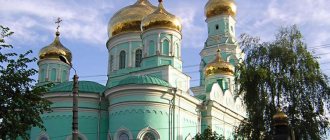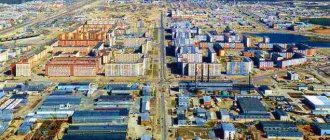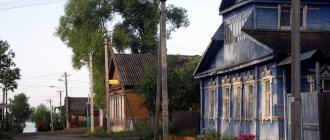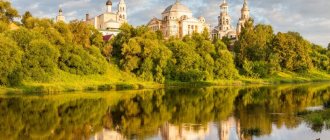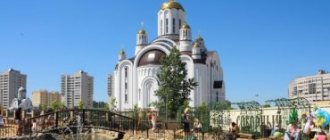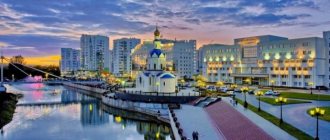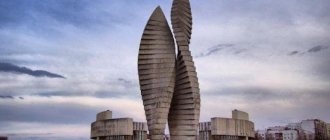| Serpukhov |
Serpukhov
, a city in Russia, the administrative center of the Serpukhov district of the Moscow region, the titular city of the Serpukhov Vicariate of the Patriarch of Moscow and All Russia within the Podolsk diocese. Located in the southern part of the Moscow region on the Nara River, 99 km from the center of Moscow. Railway and road transport hub, river port. Population - 125.9 thousand (2017).
- On the map: Yandex.Map, Google map
The official founding date is 1339 (other versions: 1328, 1336).
In 1341 - 1456 - the center of the Serpukhov-Borovsky inheritance as part of the Moscow Grand Duchy.
In 1360, Metropolitan Alexy of Moscow founded the Vladychny Monastery. In 1374, construction of a wooden Kremlin began. In the same year, Prince Vladimir Andreevich the Brave founded the Vysotsky Monastery.
In 1380, Serpukhov became one of the centers of preparation for the campaign against Mamai. The Serpukhov militia, led by Prince Vladimir the Brave, acted as part of the Ambush Regiment in the Battle of Kulikovo, which became a turning point in Russian history.
With the loss of independence, Serpukhov was included in the feeding system. In 1496-1502, in the feeding of the Kazan Khan Muhammad-Amin. In 1532-1533, in the feeding of the Kazan Khan Shigaley.
Serpukhov was repeatedly attacked and besieged: in 1382 by the troops of Tokhtamysh, in 1408 by Edigei, in 1410 by Svidrigailo.
With the construction of the stone Kremlin in 1556 by decree of Ivan IV the Terrible, Serpukhov became a significant fortress on the southern Russian borders. In 1618, it withstood a siege by the troops of the Ukrainian Hetman Sagaidachny.
In the 16th-17th centuries it was a large trade and craft center. Iron mining and processing, tanning and other crafts were developed. Built: the Church of St. Nicholas (on the site of the current cathedral), the Gate Church of the Three Saints, the walls and towers of the Vladychny Monastery, the Church of the Intercession in the Baroque style, the Church of Athanasius of Athos (dismantled in 1878), the new building of the Trinity Cathedral. In 1627, the Cathedral of the Conception in the Vladychny Monastery was rebuilt.
Since 1708 - as part of the Moscow province, since 1719 - in the Moscow province. Since 1781 it has been a district town in the Moscow province.
At the beginning of the 18th century, factories for the production of sailcloth (30% of the country's total sailcloth) appeared in Serpukhov. Since the end of the 18th century, the textile industry (cloth and calico) has been developing. By the middle of the 19th century, Serpukhov was the largest textile (cotton production) center in the Moscow province. In 1856, in the district town of Serpukhov, Moscow province, there were 22 churches. By the end of the century, in terms of population, Serpukhov took first place in the Moscow region - 30 thousand inhabitants (1897).
Textile production in Serpukhov at the turn of the 19th century developed rapidly. It was almost unaffected by the economic crisis. “Russian Manchester in miniature,” journalists described Serpukhov.
During Soviet times, Serpukhov became a significant industrial, cultural and scientific center. The leading industries of the city are mechanical engineering and metalworking, textile and food industries.
In 1934, the Kremlin was dismantled for material for the construction of the Moscow Metro. Only two tiny fragments of walls remained on the Kremlin hill. The destruction of the Church under Soviet rule led to the fact that only one Church of Elijah the Prophet operated in the city.
General information and history
Serpukhov is located in the south of the Moscow region, on the Nara River. It is separated from the capital of Russia by 99 kilometers. It is the capital of the Serpukhov region and the Serpukhov urban agglomeration. The total area of the city is 32.1 km².
COVID-19. What is known about the breakthrough drug molnupiravir? Go to article
The city was mentioned for the first time in the spiritual charter of Ivan Kalita. The date of this document could not be definitively established, but it is officially believed that Serpukhov was founded in 1339, as was first suggested. In the 70s the city began to develop intensively. A wooden Kremlin was built. It acquired political, military and economic importance. At the end of the century the mint was opened. The Serpukhovichi took part in the Battle of Kulikovo. In 1382, the city was sacked by Tokhtamysh. The city was also attacked several times in the next century.
Since the end of the 14th century, Crimean Tatars raided Serpukhov. A few decades later, in order to counteract them, it was decided to build several stone fortresses. In 1556, as part of this project, the white-stone Serpukhov Kremlin was erected. As a result, Serpukhov's military importance increased, and therefore Ivan the Terrible stationed the Great Regiment of the Russian Army in the city in 1572.
In 1605, the Serpukhovichi people recognized False Dmitry I as Tsar. Seven years later they became part of the Second Militia of Minin and Pozharsky. The weakening of the state as a result of the Time of Troubles, nomads were again able to raid Central Russia. In 1613, the Serpukhov district was ravaged by the Nogai Tatars, five years later the city was burned by Peter Sagaidachny, and in 1633 it was plundered by the Crimean Tatars. Also, due to the Troubles, Serpukhov experienced an economic decline and a decrease in population.
At the beginning of the 17th century, the fortress was greatly expanded after a fire. And in 1669, the city itself burned down, almost completely. Mostly local residents worked as blacksmiths, shoemakers, potters, tailors, and also produced iron and food products. Over forty residents were engaged as merchants outside the city. In the same century, Serpukhov began to be built up with stone buildings.
During the reign of Peter I, local residents participated in the construction of new cities, ships and fortresses. In the 1730s, Serpukhov became one of the largest cities in the Moscow region. Light industry and trade appeared. In the 60s, Serpukhov became one of the leaders of the empire in the linen industry. There are also breweries, brick factories, tanneries and one tallow factory.
A new medicine for the treatment of coronavirus. Molnupiravir is already registered in the UK. Go to article
In 1812, local residents took part in the Patriotic War. In the 1840s-60s, textile production continued to develop in the city. After this there was a decline. One of the reasons was that it was technically underdeveloped. At the same time, trade and various types of crafts successfully developed in the city. Serpukhov sold wood, bread and textiles. In the last year before the First World War, 27 factories operated in the city.
In the first days of the Great Patriotic War, several thousand townspeople went to the front. Air defense posts were created. In the fall of 1941, the Germans approached Serpukhov. Women, children, businesses and workers were evacuated from the city. At the same time, six defensive regions were formed. By the beginning of 1942, the Nazis were driven away from the city by more than 150 kilometers. After this, industry began to recover. For the needs of the front, motorcycles, food concentrates, ammunition, and tools for mechanized and tank units were produced. By 1944, the level of production reached 80% of pre-war levels. The metallurgical industry also appeared.
In total, during the war, 140 air raids were carried out on the city, almost 600 buildings were destroyed and over 200 civilians died.
SERPUKHOV
SERPOUKHOV, a city in Russia, in the Moscow region, the center of the urban district of the same name. Population 126.3 thousand people. (2019). Located on the river. Nara, near its confluence with the river. Oka. River port. Within the city limits there are several railway stations, including Serpukhov. The federal highway “Crimea” and the “Moscow Big Ring” highway pass near Serpukhov.
Story
In the 12th–13th centuries. on a high cape on the left bank of the river. Nara at the confluence of the river. Serpeika (in the center of modern Serpukhov) there was a rural settlement of the Vyatichi (jewelry, glass bracelets and ceramics were discovered), which fell into decay after the Mongol-Tatar invasion. In the 1st half. – sir. 14th centuries the village was located here. Serpokhovskoye is the center of the Serpukhov volost. It was first mentioned in 1336 as Serpokhov in the 1st spiritual charter. book Vladimir and Moscow prince. Ivan I Danilovich Kalita. In the summer 1374 books. Vladimir Andreevich founded the city of Serpukhov; under the supervision of the okolnichy Yakov Yuryevich Novosilets, an oak kremlin (perimeter 933 m) was erected, and on the floor side there was a powerful shaft (up to 8 m high); pl. Serpukhov settlement – 3.4 hectares. In the same year, near the city of St. Sergius of Radonezh founded the Vysotsky monastery in honor of the Conception of the Blessed Virgin Mary. In 1374–1456 Serpukhov was the center of the Serpukhov principality. In 1380 - end. 16th century Serpukhov is one of the main gathering places for Russian troops on the southern border. It was burned during the Tokhtamysh raid in 1382, and was soon restored. He suffered during the Edigei raid of 1408, in 1409 he was stormed and plundered by a detachment of the prince returning to the Grand Duchy of Lithuania. Svidrigailo. OK. 1556, by order of Tsar Ivan IV Vasilyevich the Terrible, a white stone Kremlin was erected. In 1618, the fortress withstood the siege of the troops of Hetman PK Sagaidachny. In 1669 the city was almost completely destroyed by fire, but was soon reborn. From the 2nd half. 17th century developed as a trade and craft center. District city of the Moscow province (1708–1929). In the 1st half. 18 – beginning 19th centuries an important center for the production of canvas, trade in bread, hemp, etc. From the horse. 18 – mid. 19th centuries one of the largest centers of the textile industry in the Moscow province (enterprises of the Konshins, Ryabovs, Tretyakovs, A.V. Maraeva, etc.). Railway traffic is open. lines Moscow - Serpukhov (1866) and Serpukhov - Tula (1867). Soviet power was established on October 26 (November 8), 1917. District (1929–63, 1965–2018) and district (1929–30) center of the Moscow region. Since 1939 it has been a city of regional subordination of the Moscow region. During the Great Patriotic War, in Oct. – Dec. 1941, during the Battle of Moscow 1941–42, was subjected to regular bombing by German aircraft and artillery shelling. In 1990–2010 it had the status of a historical city of Russia. From 2021 the center of the city district of the same name.
Architecture
Photo by A.I. Nagaev. View of the Cathedral Hill with the Trinity Cathedral and the churches: Assumption, Prophet Elijah and Trinity.
In the historical center of Serpukhov, on the left bank of the river. Nara on the Cathedral Hill (Kremlin Hill), the ramparts, remains of the white stone walls and towers of the Kremlin (dismantled in 1797 and 1934), the Trinity Cathedral of the “octagon on a quadrangle” type (1696; hipped bell tower of the early 18th century) have been preserved. On the right bank of the Serpeika there is the 5-domed Trinity Church. (possibly 1670; refectory and hipped bell tower, ca. 1714), Assumption Church. (1737–41, rebuilt in 1846–54), Baroque c. Prophet Elijah (1747–48), complex of the 5-domed Holy Cross Church. (1746–55) and c. in honor of the Pechersk Icon of the Mother of God (1808–1809); chambers and houses of the 18th century. On the left bank of the Serpeika there is a part of the city with a regular layout in 1784, with the former. Crucifixion women's mon. (founded in the 1660s, abolished in 1764; Cathedral of the Crucifixion of Christ - 1718–19, 1751 and 19th centuries; gate bell tower of the 1750s), the empire-style St. Nicholas Cathedral (Nikola Bely) (1833–57, according to project of 1831 by architect F. M. Shestakov), a square shopping area with shopping arcades (early 19th century) and a guest courtyard (1845, architect D. F. Borisov), with buildings of the 2nd half. 18 – beginning 20th centuries (Sollogubov estate, late 18th century; mansions in the style of classicism; building of the zemstvo government, 1860).
Panorama of the Vvedensky Vladychny Women's Monastery. In the background is the Vysotsky Monastery in honor of the Conception of the Blessed Virgin Mary. Photo by A.I. Nagaev.
To the south of the center is the Vysotsky male monastery in honor of the Conception of the Blessed Virgin Mary. (closed in 1928, reopened in 1991) with the 4-pillar, 5-domed Cathedral of the Conception of the Blessed Virgin Mary (after 1571; parts of the walls of the temple 1380–81; vaults and domes of the late 17th - early 18th centuries), c. St. Sergius of Radonezh (late 17th century; lower church of St. Nicholas, 1773), refectory chamber (after 1571) with church. Intercession of the Blessed Virgin Mary (1697, rebuilt in the early 19th century), gate bell tower (1831–40, architect D. F. Borisov) with a c. Three Saints (consecrated in 1843), cemetery church. All Saints (1893–96, architect R.I. Klein), walls (1664). Also on the left bank of the river. Nara - c. in honor of the Kazan Icon of the Mother of God (1737–44), c. All Saints (1859–70, architect K.V. Grinevsky; the bell tower was completed in 1875–76), a hospice house and the 5-domed Cathedral of St. Seraphim of Sarov in the neo-Russian style (1915–16, architect I.S. Kuznetsov) .
On the right bank of the river. Nara – Vvedensky Vladychny female mon. (founded as a men's cathedral in 1360 by Metropolitan Alexy; from 1806 - female; closed in 1919, resumed in 1995) with the 5-domed Vvedensky Cathedral (c. 1598, based on the temple of 1362; chapel of St. Alexy, c. 1695), refectory (1599) with a single-pillar chamber, hipped c. St. George and the belfry (completed in the late 17th century), the Holy Gate with the c. Mch. Theodotus of Ancyra (1599), chambers of cells and walls with towers (late 16th - early 17th centuries); churches - Sretenskaya (1700), St. Nicholas in Butki (1711), Pokrovskaya (1721; all of the “octagon on a quadrangle” type), the Savior Not Made by Hands (tent, 1893–96, Klein).
Centers of science and culture
Serpukhov Historical and Art Museum. Photo by E. E. Isakova.
In Serpukhov there are: Research Institute of Nonwoven Materials (1963); branches of the Moscow State University of Technology and Management. K. G. Razumovsky, Moscow State University of Instrument Engineering and Computer Science, Moscow State University of Civil Engineering, etc. Central Library System (1977; includes 7 libraries). Serpukhov Historical and Art Museum, Museum and Exhibition Center (1995). Theatres: Chamber youth theater “Through the Looking Glass” (1999, municipal since 2002), Musical and Drama Theater (2005).
Farm
Serpukhov machine-building enterprises produce turbochargers for diesel engines (“Service-Turbo”), gyroscopic devices (Metalist plant), ventilation and fire protection systems (“Serpukhov Electromechanical Plant”, 1942), power capacitors (“Serpukhov Condenser Plant”), metal structures , air cooling devices and heat exchangers (Serpukhov Mechanical Plant NPO), carbide tools (Serpukhov Instrumental), virtual reality attractions (SEMZ-Vympel), etc. Production of chemical fibers (Khimvolokno, Sertov plants) , plastic bags ("Artplast"), soap and household chemicals ("Moscow Soap Making"), thermal insulation materials ("Ursa-Serpukhov"), reinforced concrete products ("250 Plant of Reinforced Concrete Products"), cardboard and paper ("Serpukhov Cardboard and Paper Manufactory", 1879), outerwear ("Serpukhov Sewing Factory"), genuine leather and products made from it ("Serpukhov Tannery", 1781). There are “Serpukhov Cold Storage Plant” (storage of food products), food industry enterprises: “Serpukhovkhleb”, “Universal Food Technologies” (production of packaged tea), “Agrana Fruit” (fruit fillers for dairy and bakery products), etc.
Population of Serpukhov for 2021 and 2021. Number of residents of Serpukhov
Data on the number of city residents are taken from the Federal State Statistics Service. The official website of the Rosstat service is www.gks.ru. The data was also taken from the unified interdepartmental information and statistical system, the official website of EMISS www.fedstat.ru. The website publishes data on the number of residents of Serpukhov. The table shows the distribution of the number of residents of Serpukhov by year; the graph below shows the demographic trend in different years.
COVID-19. What is known about the breakthrough drug molnupiravir? Go to article
Links to official documents and resources on the population census are marked with a [*] sign; when you hover your mouse, you will see the title of the document.
| Number of residents of Serpukhov | Years |
| 125,000 people | 2006 |
| 124,200 people | 2007 |
| 123,800 people | 2008 |
| 123,429 people | year 2009 |
| 127,041 people | 2010 |
| 127,000 people | 2011 |
| 126,598 people | year 2012 |
| 126,845 people | year 2013 |
| 127,125 people | year 2014 |
| 126,728 people | 2015 |
| 126,586 people | 2016 |
| 125,929 people | 2017 |
| 125,817 people | 2018 |
Graph of population changes in Serpukhov:
The total population in 2015 was 126,836 people, and the density was 3951.28 people/km². The largest number of residents lived in the city in 1989 – 17 thousand more.
Since there is no job with a sufficient salary in the city, Serpukhovites are looking for it in the regional capital. But at the same time the number of migrants is increasing.
There are quite a lot of military people living in the city. One of the reasons for this is the location of the Serpukhov Military Institute of Missile Forces in the city.
In 2010, the national composition was distributed as follows: Russians (94.71%), Ukrainians (1.6%), Tatars (0.53%), Armenians (0.5%), Belarusians (0.44%), Uzbeks (0.34%), Azerbaijanis (0.26%), Ossetians (0.21%), Moldovans (0.19%), Tajiks (0.18%), Mordovians (0.11%) and others ( 1.16%). Ethnic burial name: Serpukhovich, Serpukhovichi
Automobile highways
The following roads pass through Serpukhov:
- M2 "Crimea" is a federal highway that passes through the territory of the following regions of the Russian Federation: Belgorod region, Moscow region, Kursk region, Oryol region. It is part of the European route E105. The total length of the route is 720 km. Road surface - concrete and asphalt.
- A108 - federal highway Moscow Big Ring (MBK). The total length of the route is 564 km. Passes through the territory of the following regions of Russia: Vladimir region, Moscow region, Kaluga region. The road surface is asphalt concrete.
Map of the city of Serpukhov. Serpukhov Yandex maps
Created using the Yandex service People's Map (Yandex map), when zoomed out you can understand the location of Serpukhov on the map of Russia. Serpukhov Yandex maps. Interactive Yandex map of the city of Serpukhov with street names, as well as house numbers. The map has all the symbols of Serpukhov, it is convenient and not difficult to use.
On the page you can read some descriptions of Serpukhov. You can also see the location of the city of Serpukhov on the Yandex map. Detailed with descriptions and labels of all city objects.
Share information with friends:
Religion
Serpukhov is located within the Moscow diocese. In 1904, the Serpukhov Vicariate of the Moscow Diocese was formed.
In the 1930s, there was also a vicariate of the Moscow Renovation diocese of the same name.
From April 13, 2021, the city of Serpukhov belongs to the independent Podolsk diocese within the Moscow Metropolis [1].
The Saints
- St. Herman of Alaska (+ 1836) - native of the city
- Sschmch. Vasily Studnitsyn, prot. (+ 1937) - native of the city
Monasteries
- Sovereign
- Vysotsky
- Raspyatsky (inactive)
Temples
- Alexander Nevsky (destroyed in 1934)
- Epiphany of the Lord
- Exaltation of the Holy Cross
- Resurrection of the Word
- All Saints
- St. George the Victorious, the first posad church (dismantled in the 18th century)
- Myrrh-Bearing Women (destroyed in the 1960s)
- Iveron Icon of the Mother of God
- Elijah the Prophet, at the Market
- Kazan Icon of the Mother of God
- Nicholas the Wonderworker:
- "St. Nicholas the White", Cathedral
- in Butki
